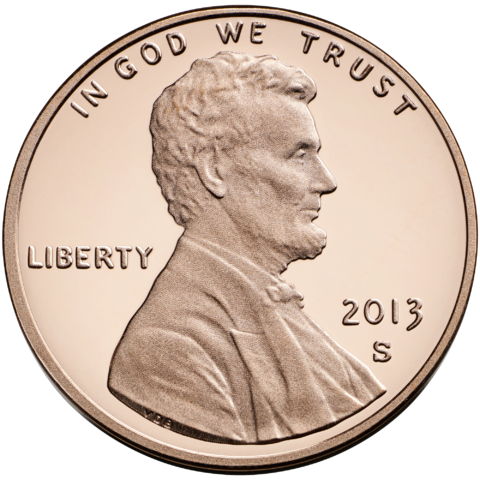1. Getting rid of the penny won't harm consumers or businesses.
In a penniless world, the unit of a cent ($0.01) would not go away. Credit cards and digital payment systems
would still be charged the exact price, down to the cent.
But cash transactions would be a different story. Because pennies wouldn't exist, all transactions paid for
in cash
would be rounded to the nearest nickel. This means a sale could only end in a 0 or a 5.
In some prices, the nearest nickel is cheaper than the price, and the price gets rounded down.
This results in a gain to the customer, because they would be paying less than the sale originally.
A customer can gain either $0.01 (light green) or $0.02
(dark green) from rounding.
In other instances, the nearest nickel is higher, and the price gets rounded up,
resulting in a benefit to the store. A store can also gain either $0.01 (light
red) or $0.02 (dark red)
from rounding.
Finally, there are prices that already end in a 0 or 5 and don't need to be rounded
at all (light grey).
These are a series of one hundred items, sampled from a real life dataset containing over three
thousand products from a convenience store chain.
Each rectangle represents the price of one item.
The data was supplied by Professor Raymond Lombra, a supporter of keeping the penny.
Lombra argues that because most items end in a 9, stores are most likely to benefit from a penniless world.
In the graphic at right, a store would gain $0.01 from each product that is light
red.
A penny does not mean much on the individual level, but consider the collective implications of eliminating
the penny.
Merchants would gain millions, while customers would lose out.
The mean of all the rounding outcomes in the distribution is $0.01 in favor of the
store.
This means that in a penniless economy, on average, one could expect most individual items to be rounded up
$0.01.
However, there is an important caveat of rounding that serves a powerful counterpoint to Lombra’s model.
It is evident that when people purchase goods as a store, they are not buying one item at a time.
Rather, a transaction can consist of multiple items, and may also include tax.
At right is a collection of one hundred real transactions from another convenience store chain, sampled in
real-time from a database.
These transactions are composed of one or more items, and may or may not include tax.
In short, this data is more realistic representation of how people buy things.
Professor Robert Whaples, a proponent of eliminating the penny, provided this data.
Transactions have ending numbers that are much more varied than individual items.
The colors are much more diverse than the previous item distribution, indicating a mixture
of rounding outcomes.
When the transactions are analyzed as a whole, it becomes even more clear that the bias towards stores has
disappeared.
There is a healthy proportion of transactions that benefit both stores and consumers,
in addition to prices that do not get rounded.
Furthermore, the mean of this distribution, rounded to the nearest nickel, is $0.00.
This indicates that an “average” transaction would undergo no rounding.
In practice, because the distribution is so diverse, there would be a wide variety of rounding outcomes.
But as a whole, rounding would balance out. Therefore, eliminating the penny and rounding to the nearest
nickel would have a nil effect.
Because transactions are so varied, it would be very hard for businesses to price-fix.
In countries that have eliminated the penny (such as Canada), legislation mandates that it is only the final transaction total that can be rounded, so customers would not have to worry about stores rounding every item.
